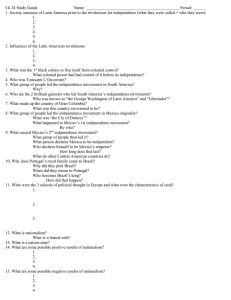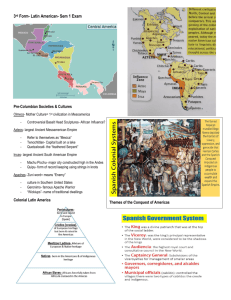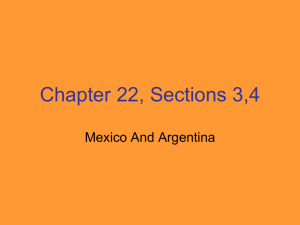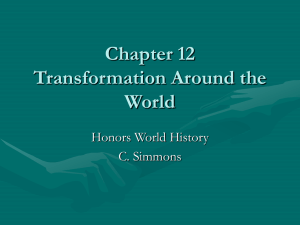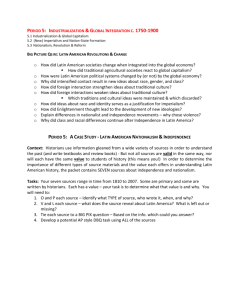Monday November 2 , 2015 Revolution and Nationalism in Latin America
advertisement
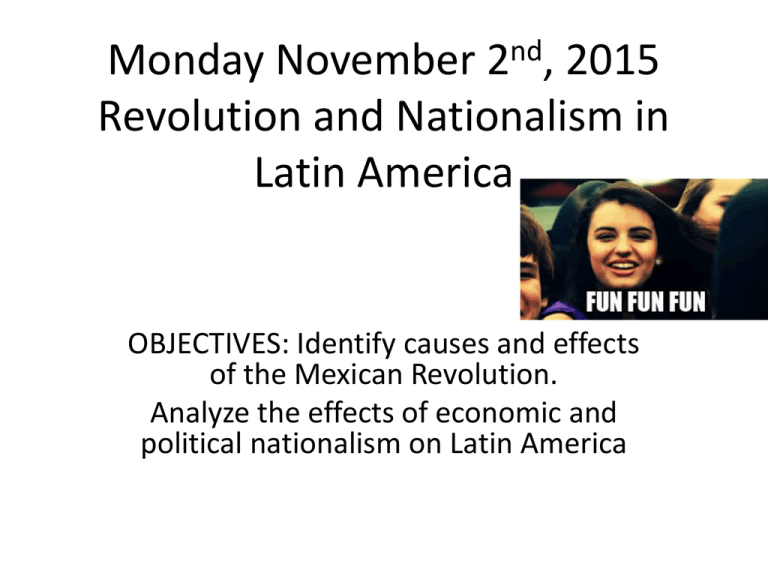
Monday November 2nd, 2015 Revolution and Nationalism in Latin America OBJECTIVES: Identify causes and effects of the Mexican Revolution. Analyze the effects of economic and political nationalism on Latin America The Mexican Revolution • Porfirio Diaz ruled Mexico for almost 35 years, winning re-election as president again and again. • Mexico enjoyed peace and economic growth. Seeds of Discontent • Unhappiness rippled through Mexico. • The country’s prosperity benefited only a small group. • Majority of Mexicans were mestizos or Indian peasants who lived in poverty. – Worked on haciendas – Meager wages. Continued… • 1910, Francisco Madero, demanded free elections. – Imprisoned by Diaz. – Revolutionaries all across Mexico joined his cause. – In 1911, Diaz resigned. A Complex Struggle • Madero was murdered in 1913, by military dictator. • Several leaders emerged. – Emiliano Zapata = led peasant revolt. • Called, “Zapatistas” cried for land and freedom. – Francisco “Pancho” Villa – Venustiano Carranza = Rich land owner, wanted political reform but did not want social change. Continued… • A million Mexicans died in fighting that lasted 10 years. – Peasants, small farmers, ranchers, and urban workers. – Soldaderas, women soldiers, cooked, tended the wounded, and even fought alongside men. – In 1917, Carranza was elected president of Mexico. • That year he signed a constitution. Economic and Social Reforms • 1917, Constitution not instituted. • 1920, Carranza is assassinated by rival revolutionaries. • Constitution is still in effect today. – Addresses three major issues: • Land (Allowed nationalization = government takeover) • Religion “Church land = property of nation” • Labor (minimum wage, protected workers’ right to strike) The PRI Takes Control • 1929, Institutional Revolutionary Party (PRI) – Made political choices to accommodate many groups in Mexican society, including business and military leaders, peasants, and workers. Social and Economic Reforms • Lazaro Cardenas, made decision to redistribute millions of acres of land to peasants under a communal land program. – Mexico began implementing reforms from Constitution of 1917. – Supported labor unions – Combated illiteracy (schools and libraries) Nationalism Spreads in Latin America • Economic Nationalism – Emphasis on home control of the economy. – To end dependence on outside industrial powers. • Took over oil resources from outsiders like USA and Britain. • Cultural Nationalism – Pride in one’s own national culture, was reflected in revival of mural painting, major art form of Aztecs and Maya. Good Neighbor Policy • United States agreed to stop interfering in the affairs of Latin American nations. • US withdrew troops. • Lasted until 1945.
